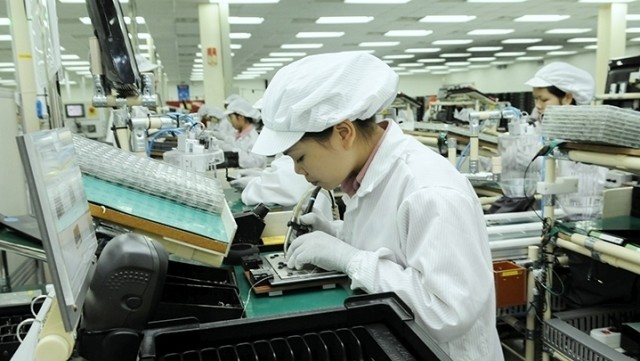Second quarter witnessing a sudden growth
Normally, Vietnam's GDP has a low growth rate in the first quarter, before accelerating gradually in the following quarters. However, the growth rate in the second quarter of this year is higher than that of the previous year, at more than 1 percentage point and can be considered as a sudden increase.
Since 2001, this situation has only happened once, coming in the second quarter of 2009. If this special case is excluded, the quarterly increase of 1 percentage point has only occurred six times from 2001 to 2016, all falling in the third quarter.
Whilst the agricultural sector contributed just 0.43 percentage points and the industrial and construction sector 2 percentage points, the service sector contributed 2.59 percentage points. It is thanks to the service sector’s growth of 6.85% in the first six months of the year. Compared to the past few years, this growth rate tends to return to the 2006-2008 period, in which Vietnam experienced the highest growth rate in almost two decades.
The basis for a “sprint”
With GDP growing dependent on the service sector, as in the first six months of 2017, the outlook for economy growth in the second half of the year is relatively bright.
Statistics from 2000 until now show that the service sector is a relatively stable growth area compared to the industry and construction sectors. Since the third quarter of 2015, this area has shown a fairly sustainable upward trend, from less than 6% to 6.85% in the second quarter of 2017.
Therefore, if the service sector continues its upward trend in the last six months of the year, it is possible for the economy to maintain a high growth rate. Of course, this implies that in order to achieve even higher growth rates, the industry-construction sector and the agricultural sector also need to regain their momentum.
The growth rate of the industry and construction sectors since 2009 has shown signs of instability. After a few quarters of recovery, it returned to a state of decline. If this rule repeats, the growth rate of the QI-2017 is likely to be the lowest in the short-term growth cycle. For that reason, the growth of the industrial and construction sectors in the following quarters is likely to be at 7-8%, as in the last three years.
Potential challenges
Against the backdrop of economic growth in the first quarter this year reaching just 5.1%, the government has put forward a range of solutions aiming to maintain the growth rate of 6.7% for the whole year. Prime Minister Nguyen Xuan Phuc issued Directive No. 24/CT-TTg requesting that the concerned ministries and sectors implement tasks and solutions to boost growth in various industries and sectors in order to achieve the 2017 economic growth target.
The most notable among the solutions is to raise the share of total social investment to GDP to a record of 34-35%. If this target is realised, it would be the highest proportion since 2010. To achieve such a high level of social investment, the government has focused on measures to accelerate the disbursement of public investment capital, lower interest rates and handle bad debt, in order to promote credit and increase foreign investment.
In recent months, the State Bank of Vietnam has made a series of actions to stimulate credit growth, such as submitting a resolution on bad debt handling and lowering the base rate by an additional 0.25 percentage point, in addition to decreasing the ceiling for short-term loans in a number of priority industries by an additional 0.5 percentage points.
However, the ability in encouraging the private sector to expand its investment may still be impeded if the government fails to persuade businesses and investors that the current measures to stimulate credit growth do not lead to high inflation or macro instability in the future.
The next noteworthy solution is to increase the exploitation of minerals, especially crude oil. The government adjusted its crude oil exploration plan in 2017 to increase domestic crude oil production by at least 1 million tonnes. However, this plan will face many challenges amidst global crude oil prices, which are returning to a downward trend.
In the context of weak domestic demand, expansion of the export market is likely to be the "exit" for Vietnam's economy to maintain its high growth momentum this year. Set in the context of the global economy showing signs of recovery, this is a good opportunity for Vietnam to increase its exports.
While the overall increase of the country's exports in the first six months in 2017 stood at 18.9%, the growth rate of the FDI sector was 21%. Due to difficulties in expanding the domestic market, as well as export volume, the domestic business sector will hardly be pushed up in the last six months of the year as the government expects.
Thus, the government's short-term growth-enhancing measures are essentially based on monetary policy, which could help the economy achieve higher growth by the end of the year.
However, the possibility that Vietnam's economy will grow at 6.7% as planned and maintain high growth in the long run remains an open question. This is highly dependent on whether Vietnam can improve its current economic growth, as it is the key factor in determining Vietnam's high and sustainable economic growth in the future.
| Economic growth in the second quarter of 2017 increased strongly thanks to the positive growth momentum in the service sector. However, the economy continues to face challenges from trade deficit accompanied by a slow disbursement rate from the State budget. The manufacturing sector is showing signs of prosperity; along with rising consumer demand, optimism with regards to the private sector’s operations will be a bright spot for economic growth in the second half of 2017. |
















